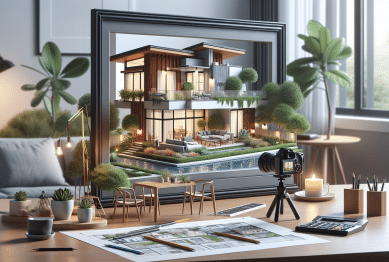Tiny homes have been turning heads across the nation in the real estate and housing sector. Discover why these compact residences continue to gain popularity, how they fit modern lifestyles, and what to know before making the shift to small-space living.
Understanding the Rise of Tiny Homes
There is a marked shift in housing trends as more people explore tiny homes for their living needs. This movement revolves around opting for smaller, more efficient spaces. Many individuals are attracted to the idea of sustainable living and reducing unnecessary expenses. This trend aligns with growing urban density, housing affordability issues, and desire for a simplified lifestyle. Tiny homes offer unique flexibility as they can be placed in both urban and rural settings, making them ideal for various demographics from young professionals to retirees.
Tiny homes do not just represent downsizing in square footage—they symbolize an intentional rethinking of how people use space. Often covering just a few hundred square feet, these homes are cleverly designed to maximize utility while minimizing waste. Some buyers see them as stepping stones toward homeownership, while others use tiny houses as vacation getaways or rental units. The compact design typically includes multi-purpose furniture and smart storage solutions, which contribute to efficient use of every inch available (Source: https://www.huduser.gov/portal/periodicals/em/fall17/highlight2.html).
A driving force behind the tiny house movement is growing environmental consciousness. Many tiny houses are constructed using energy-efficient methods and materials. Solar panels, composting toilets, and rainwater harvesting systems are common features. The carbon footprint for tiny homes is notably lower than for conventional houses, making them appealing to eco-minded homeowners. With a growing community of enthusiasts, support networks, and information resources, it is easier than ever for interested people to join the trend.
How Affordability Shapes Housing Choices
Affordability is a critical factor driving the popularity of tiny homes. Rising property prices and stagnant wages have prompted many to look for budget-friendly housing alternatives. The cost of a tiny house, whether built on wheels or foundation, is significantly lower than traditional homes. Without the burden of heavy mortgages, inhabitants often find financial freedom and flexibility. For those aiming to reduce debts, this offers a practical route to homeownership (Source: https://www.realtor.com/advice/buy/tiny-houses-guide/).
Besides initial purchase prices, ongoing expenses in tiny homes are typically reduced. These homes are easier to maintain and clean, and utility bills are lower due to the modest space. Insurance and property taxes also tend to be less. Many report their ability to allocate funds to travel, hobbies, or savings rather than being tied strictly to housing costs. This unique financial dynamic shifts housing from an obligation toward an empowering choice, especially for those navigating uncertain job markets or considering early retirement.
Some individuals take advantage of DIY building, further reducing costs by sourcing materials themselves. Others participate in cooperative communities where resources are shared, driving affordability even further. Tiny homes also create new pathways for affordable rental units, addressing shortages in densely populated areas. While zoning regulations can impose challenges, advocacy groups and relaxed municipal guidelines in some places have made it more feasible to join the tiny house community.
Maximizing Small Spaces for Comfortable Living
Luxury may be redefined in a tiny home, but comfort and convenience still take center stage. Designers have become adept at creating interiors that maximize every square foot. Built-in storage under stairs, loft sleeping areas, and transformable furniture all serve to make tiny homes feel larger than their physical footprints suggest. Natural light, open floor plans, and creative use of color schemes are common approaches to avoid a cramped atmosphere.
Technological integration further boosts tiny home comfort. Smart lighting, efficient heating and cooling, and space-saving appliances are routine in many models. These features help manage indoor air quality and temperature with minimal energy. Residents often report feeling less cluttered—both physically and mentally—after making the transition. The focus on only essential possessions aligns with a growing preference for minimalism in housing.
Despite the compact arrangement, tiny house interiors do not all look alike. Owners often add personal touches—custom finishes, cozy textiles, or art pieces—to make their homes inviting. Outdoor spaces, such as decks or gardens, are also commonly used to extend living areas, improving quality of life. Community-focused developments sometimes offer shared gardens, workshops, or recreation areas, allowing for a spacious lifestyle despite the modestly-sized residence.
The Impact of Zoning and Local Regulations
Zoning laws and building codes often determine where tiny homes can be located. Local governments may classify tiny houses differently from traditional dwellings, with rules varying about minimum square footage, foundation type, and utility connections. In some municipalities, tiny homes are viewed as accessory dwelling units (ADUs) and may be allowed in backyards or multi-home lots, aiding densities and offering solutions to housing shortages (Source: https://www.nahb.org/advocacy/industry-issues/tiny-homes).
While rules can limit placement, advocacy for tiny home-friendly policies is growing. Some regions have relaxed minimum size requirements, enabling more tiny homes to be situated legally. These changes reflect a broader recognition of diverse housing needs. However, navigating these regulations still requires research. Prospective owners should understand local requirements, which may include tie-downs for movable houses, parking, and infrastructure for utilities.
Being aware of legal guidelines protects buyers from unexpected setbacks. Some communities have even introduced tiny-house villages, offering a blend of private and shared amenities. This approach has proven desirable among singles, students, and retirees. Staying informed about developments in zoning can help home shoppers identify the right location—one where a tiny lifestyle is both permitted and celebrated.
Why Tiny Homes Appeal to Diverse Groups
Interest in tiny homes crosses age, income, and lifestyle lines. Millennials often cite freedom and environmental responsibility as motivators, while retirees may focus on accessibility and minimal upkeep. Young families with flexible work arrangements sometimes choose these homes as a way to travel or experience new communities. For some, it’s a stepping stone to larger homes in the future; for others, it becomes a permanent, cost-effective way to live.
Another segment drawn to tiny homes includes digital nomads and remote workers. Flexible home placement makes work and travel compatible, allowing for changing scenery without dramatic upheaval. Veterans, students, and people seeking to simplify their lives for mental well-being also turn toward this housing solution. With resources available online and offline, support networks have emerged to guide newcomers on their transition journey (Source: https://www.aarp.org/livable-communities/housing/info-2019/tiny-homes.html).
Social media influence and popular television programs have played a significant role in promoting tiny living. YouTube tours, design showcases, and community profiles enable would-be buyers to visualize possibilities. The movement has shed light on broader housing inequities, sparking ideas for future urban planning, homelessness solutions, and affordable housing development. Tiny homes have proven their versatility and relevance across various walks of life.
Navigating Challenges and Planning the Shift
Although tiny homes offer many benefits, transitions require careful planning. Downsizing can be both physically and emotionally demanding. Prioritizing possessions, optimizing possessions, and adjusting to a new way of life are essential for long-term satisfaction. Many suggest starting with a decluttering phase before the actual move. Resources, such as guides, online forums, and professional consultants, can provide practical support at every stage (Source: https://www.habitat.org/stories/tiny-houses-explained).
Financing and insurance pose unique considerations for tiny homes. Not all banks or insurers treat tiny houses like standard dwellings, so buyers should investigate options early in the journey. It’s also wise to weigh the pros and cons of going mobile versus anchoring to a traditional foundation, as this impacts mobility, resale potential, and regulatory compliance. Exploring different construction methods and collaborating with reputable builders ensures safety and comfort.
The adventure of tiny home living extends beyond real estate—it is also about mindset. Embracing community, valuing experiences over area, and celebrating adaptability are pivotal parts of the journey. As tiny living draws increasing attention, new organizations and advocacy efforts continue to smooth the path for interested individuals, making it easier to learn, connect, and thrive regardless of background or motivation.
References
1. U.S. Department of Housing and Urban Development. (n.d.). Highlighting Innovations: The Tiny House Movement. Retrieved from https://www.huduser.gov/portal/periodicals/em/fall17/highlight2.html
2. REALTOR®. (n.d.). Tiny Houses: Is the Tiny Life for You? Retrieved from https://www.realtor.com/advice/buy/tiny-houses-guide/
3. National Association of Home Builders. (n.d.). Tiny Homes and Construction. Retrieved from https://www.nahb.org/advocacy/industry-issues/tiny-homes
4. AARP. (n.d.). Are Tiny Homes Right for Older Adults? Retrieved from https://www.aarp.org/livable-communities/housing/info-2019/tiny-homes.html
5. Habitat for Humanity. (n.d.). Tiny Houses Explained. Retrieved from https://www.habitat.org/stories/tiny-houses-explained
6. National Public Radio. (n.d.). The Rise and Challenges of Tiny Home Living. Retrieved from https://www.npr.org/sections/alltechconsidered/2017/12/13/570349233/the-rise-and-challenges-of-tiny-home-living









